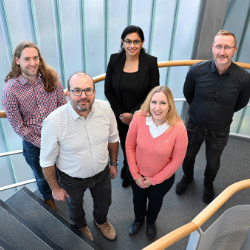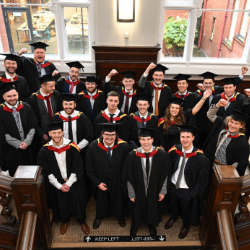-
Study
-
Quick Links
- Open Days & Events
- Real-World Learning
- Unlock Your Potential
- Tuition Fees, Funding & Scholarships
- Real World Learning
-
Undergraduate
- Application Guides
- UCAS Exhibitions
- Extended Degrees
- School & College Outreach
- Information for Parents
-
Postgraduate
- Application Guide
- Postgraduate Research Degrees
- Flexible Learning
- Change Direction
- Register your Interest
-
Student Life
- Students' Union
- The Hub - Student Blog
- Accommodation
- Northumbria Sport
- Support for Students
-
Learning Experience
- Real-World Learning
- Research-enriched learning
- Graduate Futures
- The Business Clinic
- Study Abroad
-
-
International
International
Northumbria’s global footprint touches every continent across the world, through our global partnerships across 17 institutions in 10 countries, to our 277,000 strong alumni community and 150 recruitment partners – we prepare our students for the challenges of tomorrow. Discover more about how to join Northumbria’s global family or our partnerships.
View our Global Footprint-
Quick Links
- Course Search
- Undergraduate Study
- Postgraduate Study
- Information for Parents
- London Campus
- Northumbria Pathway
- Cost of Living
- Sign up for Information
-
International Students
- Information for International Students
- Northumbria and your Country
- International Events
- Application Guide
- Entry Requirements and Education Country Agents
- Global Offices and Regional Teams
- English Requirements
- English Language Centre
- International student support
- Cost of Living
-
International Fees and Funding
- International Undergraduate Fees
- International Undergraduate Funding
- International Masters Fees
- International Masters Funding
- International Postgraduate Research Fees
- International Postgraduate Research Funding
- Useful Financial Information
-
International Partners
- Agent and Representatives Network
- Global Partnerships
- Global Community
-
International Mobility
- Study Abroad
- Information for Incoming Exchange Students
-
-
Business
Business
The world is changing faster than ever before. The future is there to be won by organisations who find ways to turn today's possibilities into tomorrows competitive edge. In a connected world, collaboration can be the key to success.
More on our Business Services-
Business Quick Links
- Contact Us
- Business Events
- Research and Consultancy
- Education and Training
- Workforce Development Courses
- Join our mailing list
-
Education and Training
- Higher and Degree Apprenticeships
- Continuing Professional Development
- Apprenticeship Fees & Funding
- Apprenticeship FAQs
- How to Develop an Apprentice
- Apprenticeship Vacancies
- Enquire Now
-
Research and Consultancy
- Space
- Energy
- AI and Tech
- CHASE: Centre for Health and Social Equity
- NESST
-
-
Research
Research
Northumbria is a research-rich, business-focused, professional university with a global reputation for academic quality. We conduct ground-breaking research that is responsive to the science & technology, health & well being, economic and social and arts & cultural needs for the communities
Discover more about our Research-
Quick Links
- Research Peaks of Excellence
- Academic Departments
- Research Staff
- Postgraduate Research Studentships
- Research Events
-
Research at Northumbria
- Interdisciplinary Research Themes
- Research Impact
- REF
- Partners and Collaborators
-
Support for Researchers
- Research and Innovation Services Staff
- Researcher Development and Training
- Ethics, Integrity, and Trusted Research
- University Library
- Vice Chancellors Fellows
-
Research Degrees
- Postgraduate Research Overview
- Doctoral Training Partnerships and Centres
- Academic Departments
-
Research Culture
- Research Culture
- Research Culture Action Plan
- Concordats and Commitments
-
-
About Us
-
About Northumbria
- Our Strategy
- Our Staff
- Our Schools
- Place and Partnerships
- Leadership & Governance
- University Services
- Northumbria History
- Contact us
- Online Shop
-
-
Alumni
Alumni
Northumbria University is renowned for the calibre of its business-ready graduates. Our alumni network has over 253,000 graduates based in 178 countries worldwide in a range of sectors, our alumni are making a real impact on the world.
Our Alumni - Work For Us
Christine Borland, Professor of Art at Northumbria University, comments on The Turner Prize for The Conversation.
The latest exhibition for the biggest award in contemporary British art, the Turner Prize, is now open at Glasgow’s Tramway. It comes as no surprise that responses to the show of the four shortlisted artists have so far been lukewarm.
As a shortlisted artist participating at the Tate in 1997, the compromises required to make everything “fit” the lumbering Turner Prize machine overwhelmed both the work and possibilities for its interpretation. This year that homogenisation extends to turning Tramway, one of the UK’s most distinctive and cavernous exhibition spaces, into a claustrophobic warren of corridors and white cubes.
Tramway director, Sarah Munro, has said: “In truth the Turner Prize and those artists associated with it don’t really tell the full story … the context is much more layered.” This hints at the complex power dynamics which dominate the prize. The ethos of the Turner is the antithesis of the artist-led communities and workspaces in which many of the nominated artists were nurtured. Having directed what began life as an artist’s collective, The Collective Gallery in Edinburgh, for many years, Munro is acutely aware of this.
Over the last 15 years, galleries, museums and the Turner Prize itself have struggled to present a more socially engaged practice that crosses“boundaries between art, activism, urbanism, anthropology and many other fields”. Most often this “complex, contradictory and unruly area of practice” loses its vitality in the process.
But this year, Assemble, an architecture collective, nominated for their work on a Liverpool housing project, do manage to look distinctive. They have translated their work into an “exhibit” by building the self-contained, enclosed Granby Workshop Showroom, with products and samples made by residents in their
Tate on tour
Locating the Turner show in Glasgow is also part of this push to extend boundaries and venture beyond the ivory towers of Bankside’s Tate Britain. This year’s show is the fourth of its now biennial manifestations outside of London, having already decamped around the country to venues in Liverpool, Newcastle, and Derry.
Penelope Curtis, Tate Britain’s director, says: "Given how many artists from Glasgow have made up the Turner Prize shortlists over recent years, it is great to have the prize on show in Tramway, which feels like a natural home for the prize this year."
“Home” is an emotive idea. In the run up to the exhibition, home and identity have dominated discussions for all the wrong reasons. For the first time since 2004, none of the four shortlisted Turner Prize artists are Scottish, or based in Scotland. Outraged local press speculate about their deliberate exclusion by the prize’s selection committee, while Guardian critic, Jonathan Jones was outraged that an accompanying touring exhibition of previous Scottish Turner Prize winners and nominees “reeks of Tartan fetishism”.
But the fuss around (the exclusion of) the home team overshadows the fact that, for the first time in years, all of the artists actually have London as their chosen base.
The continued draw of the capital is at odds with a general perception that artists are fleeing to northern parts because of the pace of gentrification. Artists occupy a new area; are inevitably evicted as it becomes more desirable; the space is then co-opted by investors. This is not to say that cities outside London feel any benefit from this: although the gentrification of London may continuously uproot artists from their communities, the city is overwhelmingly good for the art market and, in turn, for institutions like the Tate. Despite rocketing prices, London retains its artistic allure.
This is in stark contrast to Derry, the venue for the 2013 Turner Prize, where the planned “cultural hub” around the gallery which hosted the exhibition is now an office complex. The same cycle can be seen repeated in the other Turner Prize host cities outside of London.
At a recent symposium in Newcastle’s NewBridge Project, the 200 or so tenants of this artist-led community of studios and exhibition spaces at risk of losing their city centre premises to redevelopment, were asked whether it was time for artists to “grow up” and accept the new agenda of cuts, philanthropy and big business sponsorship. Their answer resonates for any artist trying to find a way to work and survive while negotiating situations which are out with their control: “No, we don’t need to grow up – not if growing up means compromising our values or forgetting why we became artists in the first place.”
Environmental art
For me, returning back to working as an artist in Glasgow after the Turner Prize meant the simple pleasures of home and a clear artistic identity, built on a slow and steadily developed practice; creating my own, unmediated relationship with the “public” who were at the centre of my research and practice. This way of working was fostered by the core curriculum of the environmental art department at Glasgow School of Art, where I studied. Regular public art projects forced students out of their studios to consider how to make work in public space, temporarily exhibiting the results in that context.
While Tate branding will always reinforce the association with the capital, a lasting legacy of the Turner’s residency in Glasgow would be for the prize, to become truly itinerant, allowing artists and their works to move out of the bricks and mortar of the white gallery space all together.
This direct response to artist’s working methods would allow freedom for both them and audiences from the hierarchies which currently permeate and dominate too many of the debates around the Turner. Experience of the Turner Prize would be based on public participation, not a second-hand media storm in a teacup or reliance on the accompanying “programme of workshops, talks, tours and activities for people of all ages to get involved and be inspired by the creative work on show”.
Nicholas Serota, director of Tate, tells us that the Tate Modern extension will be “a communal place where people can meet to share, debate and create”. It is time the same aspiration was extended to enable the Turner Prize to really come “home” and find a place where the power of the art, not the structures of power, is centre stage.
This article was originally published on The Conversation. Read the original article.
News
- First cohort of Civil Engineering Degree Apprentices graduate from Northumbria
- Venice Biennale Fellowship
- Northumbria expands results day support for students
- Northumbria academic recognised in the British Forces in Business Awards 2025
- £1.2m grant extends research into the benefits of breast milk for premature babies
- Northumbria graduate entrepreneur takes the AI industry by storm
- Study identifies attitudes towards personal data processing for national security
- Lifetime Brands brings student design concept to life
- New study reveals Arabia’s ‘green past’ over the last 8 million years
- How evaluation can reform health and social care services
- Researchers embark on a project to further explore the experiences of children from military families
- Northumbria University's pioneering event series returns with insights on experiential and simulated learning
- Support for doctoral students to explore the experiences of women who have been in prison
- Funding boost to transform breastfeeding education and practice
- A new brand of coffee culture takes hold in the North East
- BBRSC awards £6m of funding for North East Bioscience Doctoral Students
- £3m funding to evaluate health and social care improvements
- Balfour Beatty apprentices graduate from Northumbria University
- Long COVID research team wins global award
- Northumbria researchers lead discussions at NIHR event on multiple and complex needs
- Healthcare training facility opens to support delivery of new T-level course
- Young people praise Northumbria University for delivery of HAF Plus pilot
- Nursing academics co-produce new play with Alphabetti Theatre
- Research project to explore the experiences of young people from military families
- Academy of Social Sciences welcomes two Northumbria Professors to its Fellowship
- Northumbria University set to host the Royal College of Nursings International Nursing Research Conference 2024
- 2.5m Award Funds Project To Encourage More People Into Health Research Careers
- Advice available for students ahead of A-level results day
- Teaching excellence recognised with two national awards
- Northumbria law student crowned first Apprentice of the Year for the region
- Northumbria University launches summer activities to support delivery of Holiday Activities and Food programme
- UK health leader receives honorary degree from Northumbria University
- Use of AI in diabetes education achieves national recognition
- Research animation explores first-hand experiences of receiving online support for eating disorders
- Careers event supports graduate employment opportunities
- Northumbria University announces £50m space skills, research and development centre set to transform the UK space industry
- The American Academy of Nursing honours Northumbria Professor with fellowship
- New report calls for more support for schools to improve health and wellbeing in children and young people
- AI experts explore the ethical use of video technology to support patients at risk of falls
- British Council Fellows selected from Northumbria University for Venice Biennale
- Prestigious nomination for Northumbria cyber security students
- Aspiring Architect wins prestigious industry awards
- Lottery funding announced to support mental health through creative education
- Early intervention can reduce food insecurity among military veterans
- Researching ethical review to support Responsible AI in Policing
- Northumbria named Best Design School at showcase New York Show
- North East universities working together
- Polar ice sheet melting records have toppled during the past decade
- Beyond Sustainability
- Brewing success: research reveals pandemic key learnings for future growth in craft beer industry
- City's universities among UK best
- Famous faces prepare to take to the stage to bring a research-based performance to life
- Insights into British and other immigrant sailors in the US Navy
- International appointment for law academic
- Lockdown hobby inspires award-winning business launch for Northumbria student
- Lasting tribute to Newcastle’s original feminist
- Outstanding service of Northumbria Professor recognised with international award
- Northumbria academics support teenagers to take the lead in wellbeing research
- Northumbria University becomes UK's first home of world-leading spectrometer
- Northumbria's Vice-Chancellor and Chief Executive to step down
- Out of this world experience for budding space scientists
- Northumbria engineering graduate named as one of the top 50 women in the industry
- Northumbria University signs up to sustainable fashion pledge
- Northumbria demonstrates commitment to mental health by joining Mental Health Charter Programme
- Virtual reality tool that helps people to assess household carbon emissions to go on display at COP26
- EXPERT COMMENT: Why thieves using e-scooters are targeting farms to steal £3,000 quad bikes, and what farmers can do to prevent it
- Exhibition of lecturer’s woodwork will help visitors reimagine Roman life along Hadrian’s Wall
- Students reimagine food economy at international Biodesign Challenge Summit
- Northumbria storms Blackboard Catalyst Awards
- Breaking news: Northumbria’s Spring/Summer Newspaper is here!
- UK’s first ever nursing degree apprentices graduate and join the frontline
- Massive decrease in fruit and vegetable intake reported by children receiving free school meals following lockdown
- Northumbria awards honorary degrees at University’s latest congregations
Latest News and Features

Report calls on the UK banking industry to consider interventions that "design out" economic abuse
Researchers have published the findings of a ground-breaking study which brought together victim-survivors…
.png?modified=20251222122622)
Northumbria's ‘Banana Split: Unpeeling a New Energy Source’ project highly commended at prestigious Green Gown Awards
A Northumbria University research project has been highly commended at the 2025 Green Gown…

Northumbria ranked most sustainable university in the North East for fifth consecutive year
Northumbria University has been rated as ‘1st class’ for sustainability and is once again the…

Northumbria expert delivers training to help address victim-blaming language
A Northumbria University academic is leading pioneering training to support police forces across…

Northumbria University launches national AI challenge inviting young people to imagine a hopeful future
Northumbria University has launched the Hopeful Futures AI Challenge, a groundbreaking national…

Student volunteering partnership expands following five years of community impact
Following the success of a Law in the Community project, Northumbria University is expanding…

Funding awarded for innovative space technology projects
The North East Space Communications Accelerator (NESCA) has successfully awarded its first…

First cohort of Civil Engineering Degree Apprentices graduate from Northumbria
The inaugural cohort of Civil Engineering degree apprentices have graduated from Northumbria…
Upcoming events

Collaborating for Capability: Shaping the Future of Supply Chain Talent
City Campus East, Northumbria University CCE1-403
-

Archives to Action: Historical Evidence for Policy Reform
Virtual Workshop
-

Viruses of Microbes-UK (VoM-UK) Conference 2026
Northumbria University

Commercialising SHAPE Innovations and Impact
Northumbria University
-
